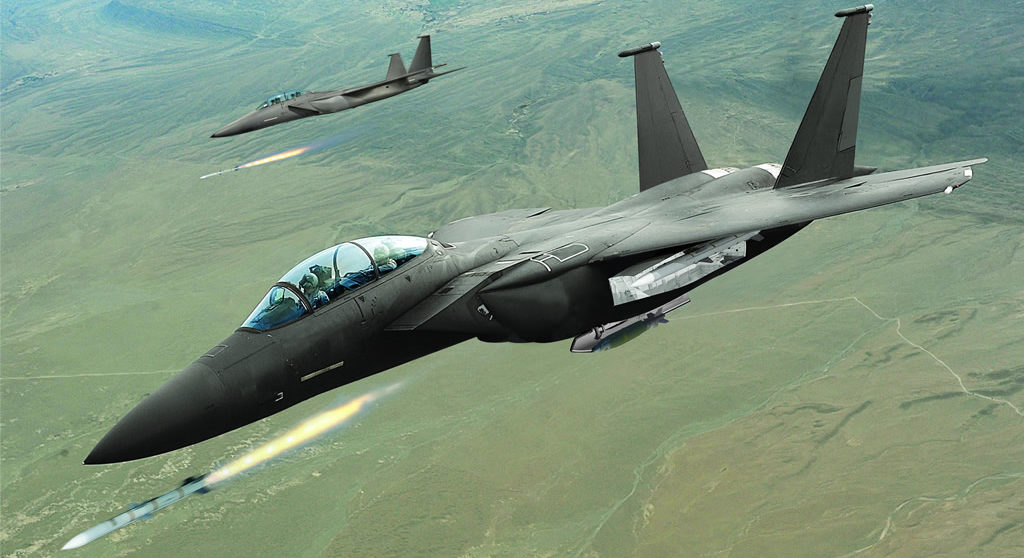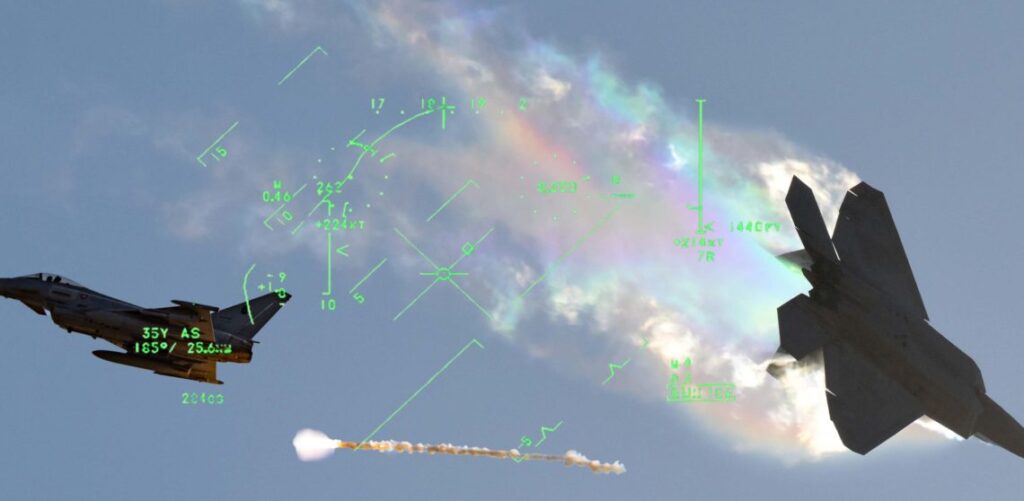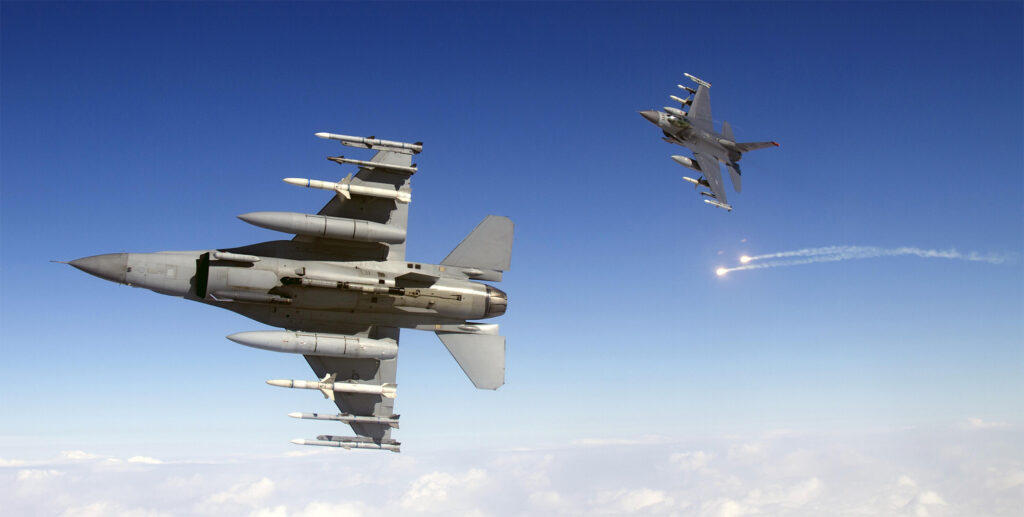Back in 2009, Boeing’s Silent Eagle aimed to make the world’s most prolific air superiority fighter into something more by injecting stealth into the F-15’s legendary DNA. The result may have been the most broadly capable F-15 the world had ever seen, delivered just in time to compete with what would become a foreign sales powerhouse, the F-35 Joint Strike Fighter.
The F-15SE Silent Eagle aimed to bridge the gap between fourth and fifth-generation fighters, incorporating elements of the stealth and situational awareness offered by the world’s most advanced tactical jets into an already legendary fighter airframe. With 58,000 pounds of thrust on tap, internal weapons carriage capabilities, a reduced radar signature, advanced avionics and the Strike Eagle’s multi-role pedigree, this fighter may have been the most capable 4th generation platform on the planet by the time it was rolled onto the flight lines of prospective buyers hailing from Canada to Japan and everywhere in between.
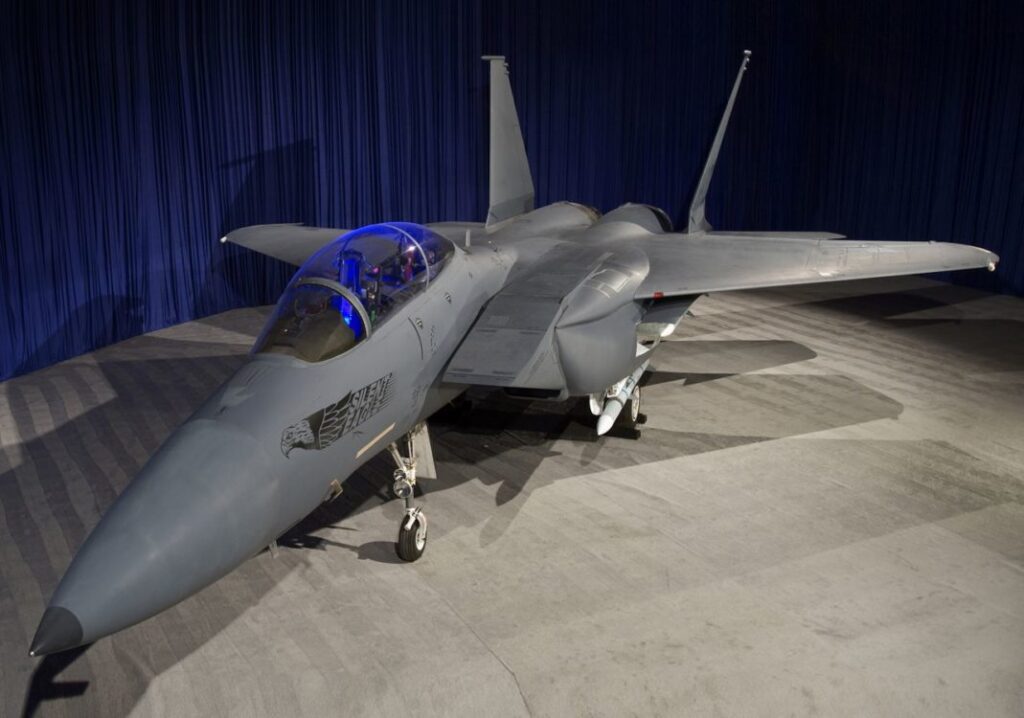
But the world was changing by the 2010s, and the skies above it were no exception. In an era of advanced and stealthy fighters fusing data on the fly and slipping past enemy radar arrays like James Bond and his trusty Walther PPK… the Silent Eagle was more like Robocop carrying a shotgun with a silencer. It was a mechanical powerhouse that could tiptoe through the sky and speak in hushed tones. But beneath the thin veneer of stealth, the F-15SE was still every bit the bruiser it started out as.
Designed to square off against the fighter equivalent to the boogeyman
The F-15’s journey to fruition started in the dogfights over Vietnam, but found renewed focus when the Soviet Union unveiled the Mikoyan-Gurevich MiG-25 Foxbat at the Domodedovo airfield near Moscow in 1967. This new fighter was clearly fast, with massive air intakes defining its frontal view and engine outlets you could have a picnic in at the back.
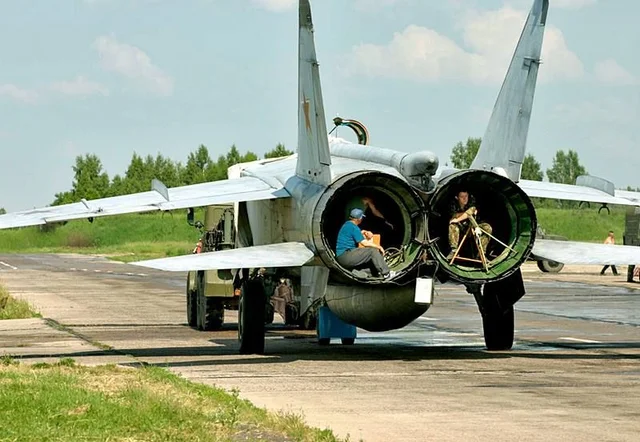
Based on their own studies of large wings on high-speed aircraft, the MiG-25’s design looked highly maneuverable to American engineers, and concerns about its capabilities worsened just a few short years later when Israeli radar operators picked up an unusual Soviet fighter in their airspace traveling at an astonishing Mach 3.2 at higher altitudes than any NATO fighter could manage.
The Air Force, keen to offset this apparent capability gap, redoubled their efforts to field a new purpose-built air superiority fighter, and they did so with the new Foxbat squarely in their crosshairs.
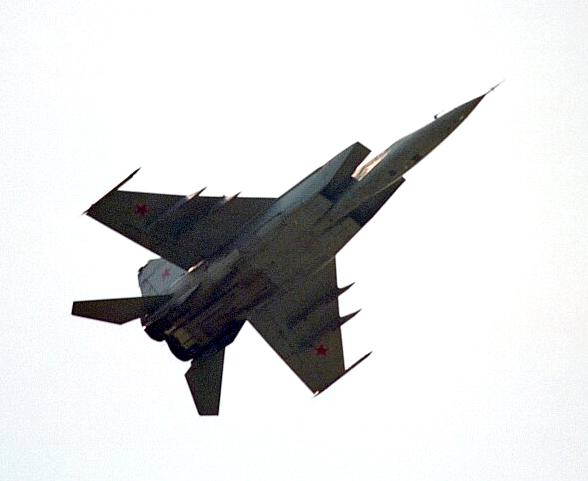
Within just five years, America’s new F-15 Eagle would enter service. It could fly at speeds in excess of Mach 2.5, thanks to a pair of powerful Pratt & Whitney F100-PW-220 after-burning turbofans that actually produce more thrust than the aircraft’s drag and weight combine to, making the F-15 so powerful that it can actually accelerate while flying straight up.
That high thrust-to-weight ratio coupled with a low weight-to-wing area also allows for a high degree of maneuverability, making for what the Air Force hoped would be a superior combination of traits when compared to the Soviet powerhouse MiG-25.
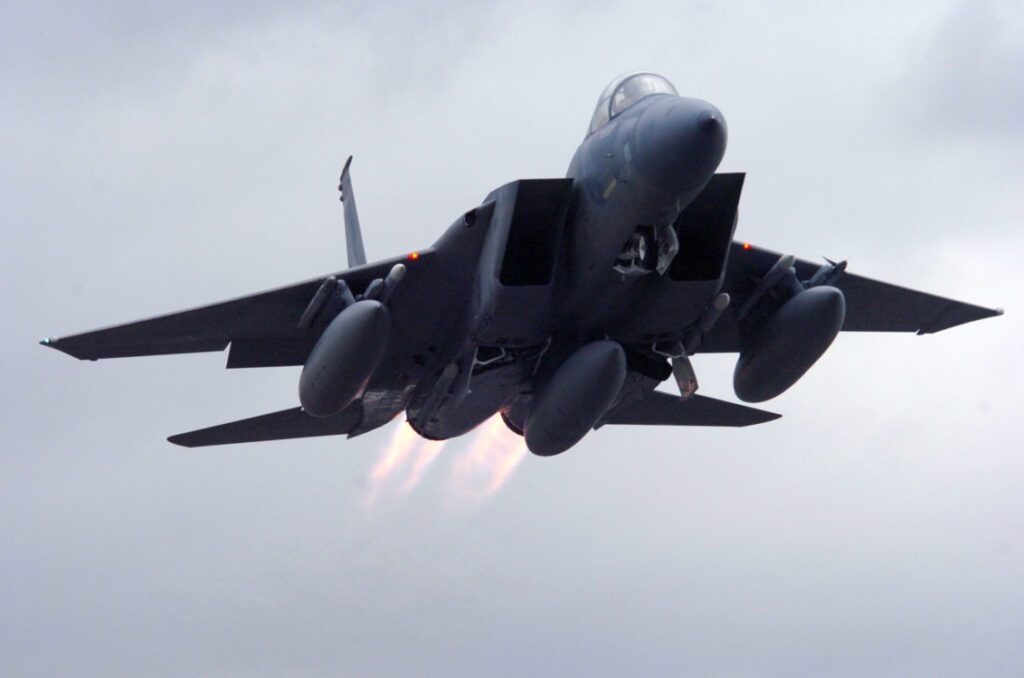
Of course, a few years later, America would get their hands on one and come to learn that the MiG-25 wasn’t actually all that capable—or scary—at all. The F-15 had been invented to serve as a silver bullet against a monster Soviet fighter with seemingly no peers on the world’s stage. But with the Foxbat now understood to be a subpar competitor, America’s F-15 graduated from its perceived underdog status to becoming the most dominant air superiority fighter of its century.
In 1986, the next iteration Eagle, dubbed the F-15E, added new conformal fuel tanks along the aircraft’s fuselage to carry an additional 750 gallons on each side, adorned with short pylons that can carry external munitions without the increased drag created by conventional weapons racks. Hardpoints for practically every air-to-ground munition in the U.S. arsenal were incorporated, from the Eagle’s familiar AIM-9 Sidewinder missiles to America’s latest variable-yield B61-12 nuclear bombs, making the new Strike Eagle a competitor for best multi-role strike fighter of its century as well. In fact, the F-15E would beat out the unusual and extremely promising delta-winged F-16XL for a shot at service.
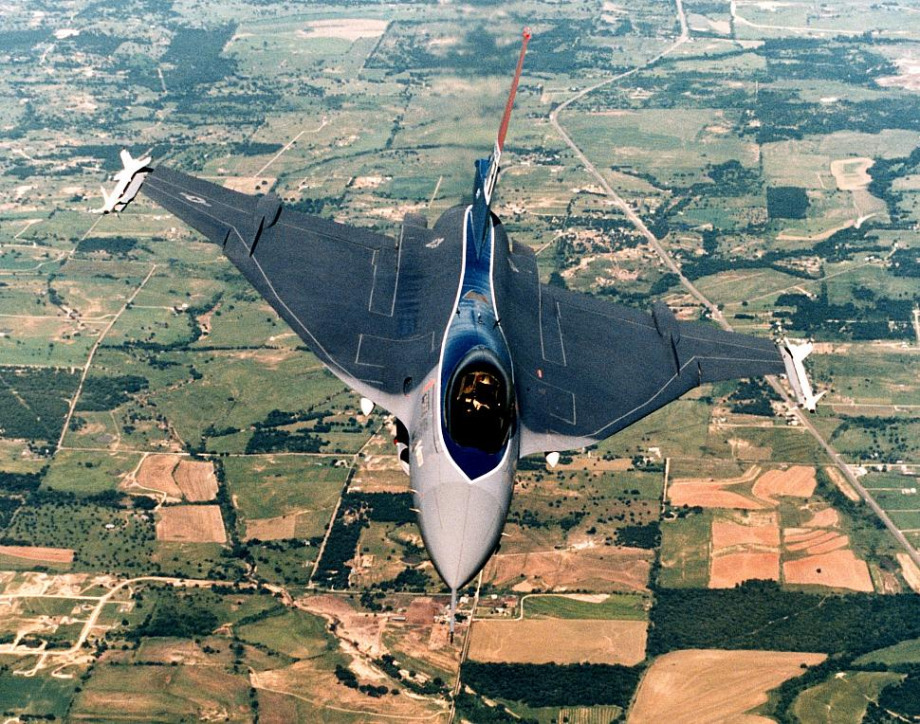
To coincide with the increased range and payload capabilities, new avionics, including improved radar and a Low Altitude Navigation and Targeting Infrared for Night (LANTIRN) system for air-to-ground targeting helped turn the air superiority fighter into a deep-strike interdiction platform that had no need for escort fighters. In order to manage all of this, a second seat for a weapons officer was added with four screens displaying information from the radar, electronic warfare or infrared sensors that can be used to track or select targets, monitor weapons, aid in navigation, and more.
The need for a stealth F-15
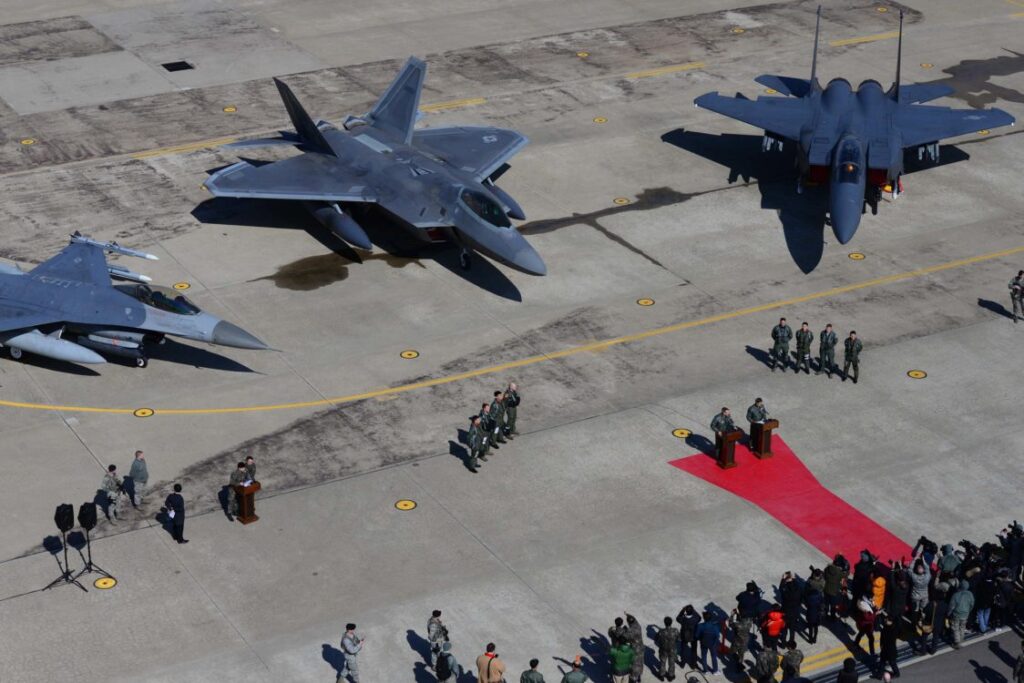
As dominant as the F-15 platform may have been in the skies over the Cold War, the 21st century brought a new slew of challenges for America’s workhorse air superiority fighter. By 2005, stealth had found its way into the fighter realm with the F-15’s intended replacement, Lockheed Martin’s incredible new F-22 Raptor.
But with just 186 F-22s ultimately built, the F-15 soon found itself serving as America’s primary air superiority fighter once again, while the F-15E was proving invaluable across conflicts in the Middle East. But it wasn’t all good news for Boeing and its Eagle. The F-22 may have been canceled, but the F-15E’s ground attack capabilities were now facing a new stealthy threat on the fighter sales market in the form of the new and attack-oriented F-35 Joint Strike Fighter. Boeing had competed and lost for the Joint Strike Fighter contract with their X-32, leaving their hopes for lucrative fighter contracts resting squarely on the F-15’s rapidly aging shoulders.
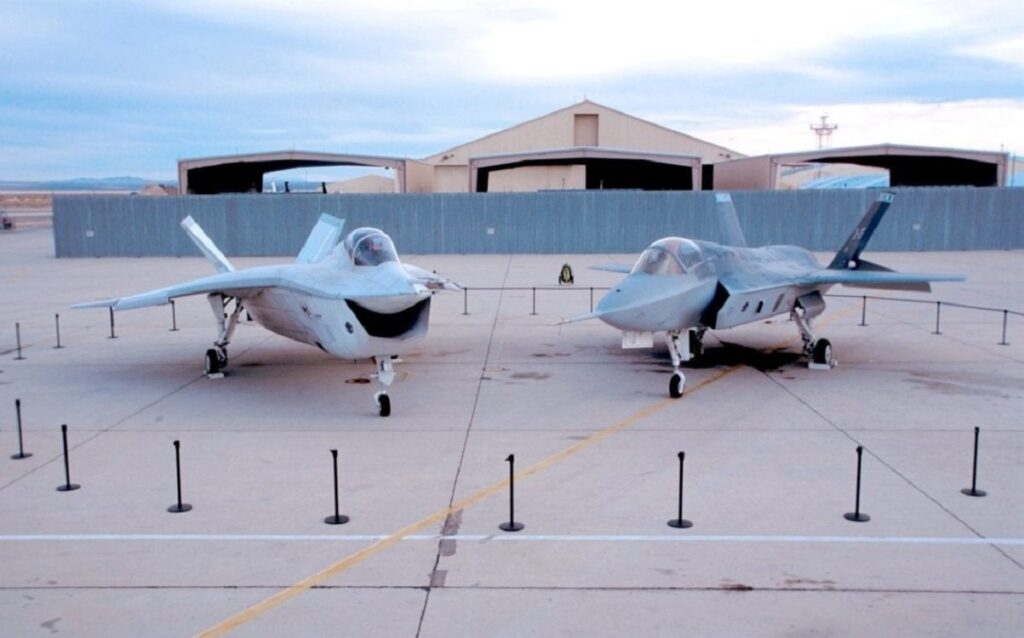
Then, in 2008, Boeing’s Director for F-15 Development Programs, Brad Jones, met with a Korean general who gave him an idea he believed could renew interest in the aging fighter warhorse.
“This [program] started when we were at a conference in Korea in 2008. A Korean general basically said, ‘We have to have stealth but can we live with the tradeoffs?’” Jones recounted in 2011.
“We listened. Stealth is very expensive to maintain. These guys will fly these airplanes for 30-plus years and technology will [bypass] stealth. Radar cross section is just in the X-band. We’re now moving into multi-spectral areas.”
Jones could see the writing on the wall. If Boeing wanted to continue selling its Cold War powerhouse to the U.S. and its allies, it was time to give it a serious injection of 21st-century technology that would make it a viable competitor for nations who were unsure about going all-in on an expensive new stealth fighter.
The birth of the F-15SE Silent Eagle
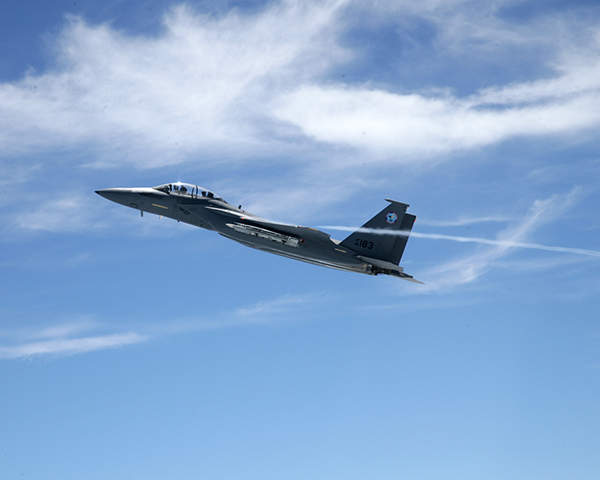
Boeing recognized immediately that they had no hope of making the F-15 truly stealth. After all, we’re talking about an aircraft said to carry a 25 square meter radar cross-section. That’s more than twice that of the B-1B Lancer heavy payload bomber and at least 25 times bigger than an F/A-18 Super Hornet. So in order to make their Silent Eagle concept work, Boeing had to do two things: bring the F-15’s radar return down dramatically, and convince potential buyers that stealth wasn’t the only important factor to consider when buying new fighters.
In March of 2009, Boeing unveiled their new fighter, or more appropriately, the newest iteration of the F-15E and subsequent F-15SA. Their New two-seat F-15SE Silent Eagle built upon the changes made for the Strike Eagle and its more recent Saudi Arabian export sibling, this time emphasizing a reduction in the fighter’s radar return alongside another round of avionics and system updates and upgrades.
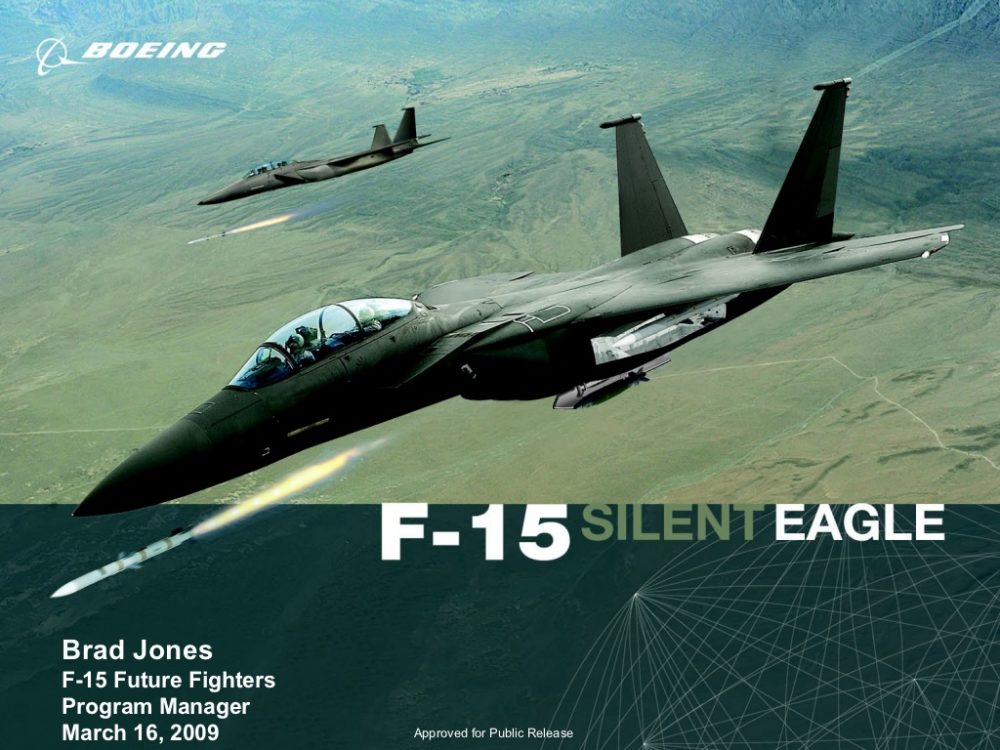
The result was an F-15 that looked quite a bit like a stripped-down old one, but with some very important changes. Most notably, the 750-gallon conformal fuel tanks were removed from the fighter’s fuselage and replaced with new conformal weapons bays (CWBs) that were very similar in external design to the fuel tanks they replaced. This allowed the Silent Eagle to carry its firepower internally like 5th generation fighters, eliminating the radar return created by external munitions while maintaining a similar aerodynamic profile to the Strike Eagle that had already proven itself in service.
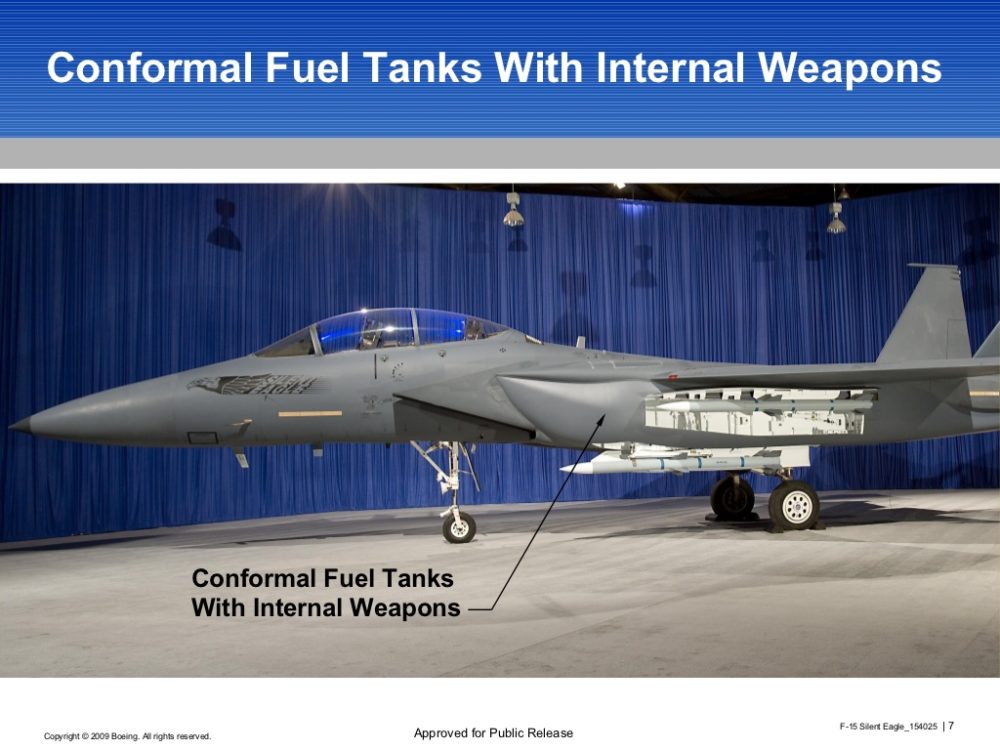
“It’s the fastest fighter out there,” Jones said. “It goes farther, it carries more, it fights at 50,000 feet, it shoots missiles at Mach 1.5 to 1.8. It’s an air superiority, multi-role, air-to-ground aircraft we can deliver in 2015. It’s ready to use, in service right now.”
These conformal weapons bays were rated to carry AIM-9 Sidewinder and AIM-120 AMRAAM air-to-air missiles, JDAM satellite-guided bombs, and Small Diameter Bombs, among others. One important inclusion, as reported by the now-legendary aviation reporter Steve Trimble all the way back in 2012, was the Raytheon AGM-88 high-speed anti-radiation missile (HARM) commonly leveraged by Wild Weasel aircraft hunting for enemy radar systems, making the Silent Eagle a viable and even potent option for SEAD (Suppression of Enemy Air Defenses) operations.
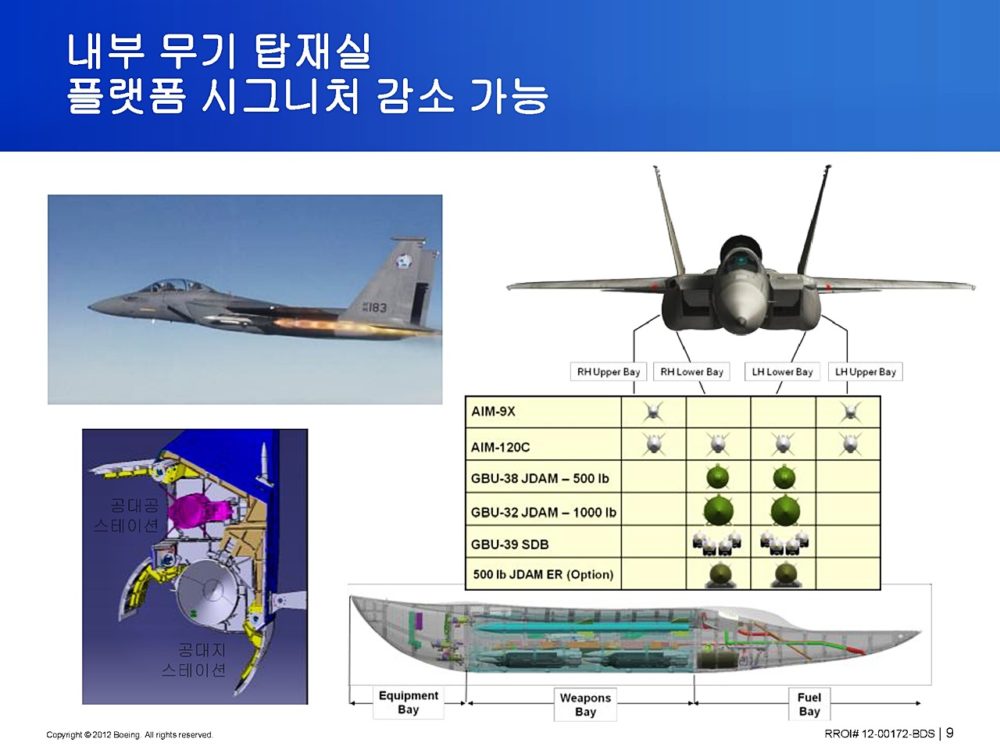
The Silent Eagle’s CWBs could be removed and replaced with standard Strike Eagle conformal fuel tanks when the mission called for less stealth and more hate, trading four additional weapons stations and 1,500 gallons of added fuel for the Silent Eagle’s discretion.
External missiles and fuel drop tanks were removed from the wings to further reduce the jet’s radar return. A BAE digital electronic warfare suite (DEWS) suite was added to supplement the aircraft’s stealth with jamming capabilities, alongside the Active Electronically Scanned Array radar, and an infrared search and track (IRST) sensor for both air-to-air and air-to-ground operations.
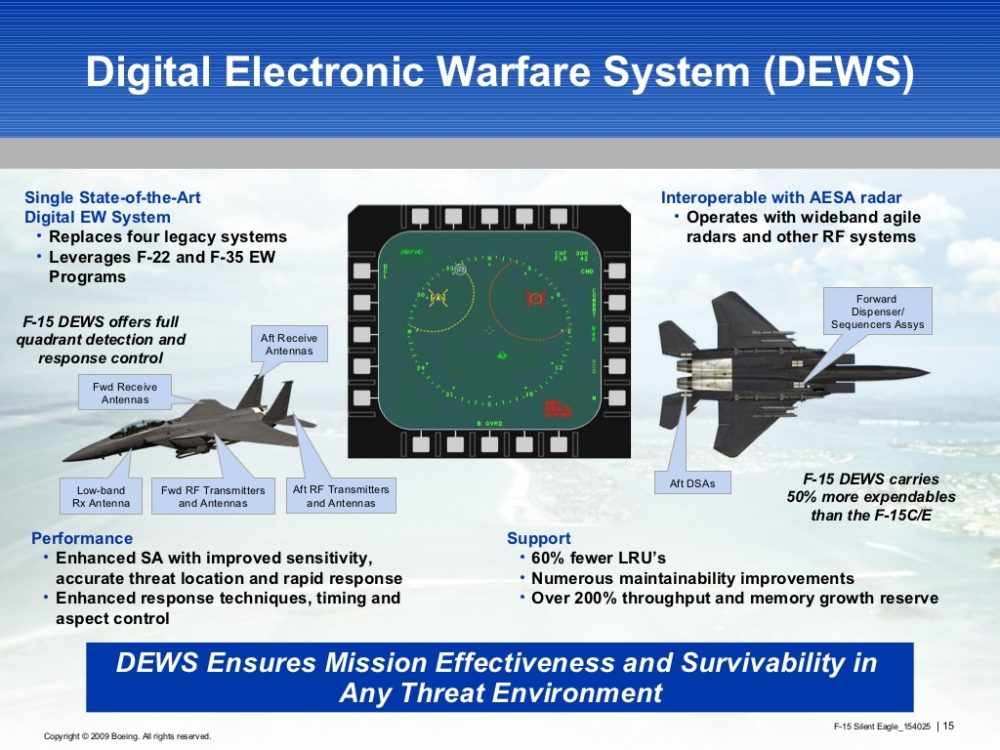
The IRST would allow the F-15SE to hunt for enemy fighters without using active radar that would alert them of its presence. The Strike Eagle also has this capability, but the sensor is housed within one of the wing-mounted pods that would be eliminated in the F-15SE, making the addition of the sensor within the fuselage a necessary change. The Silent Eagle would also leverage new fly-by-wire controls funded originally by Saudi Arabia for their F-15SA.
Two external weapons stations allowed for an additional four air-to-air missiles when the F-15SE wasn’t worried about being sneaky.
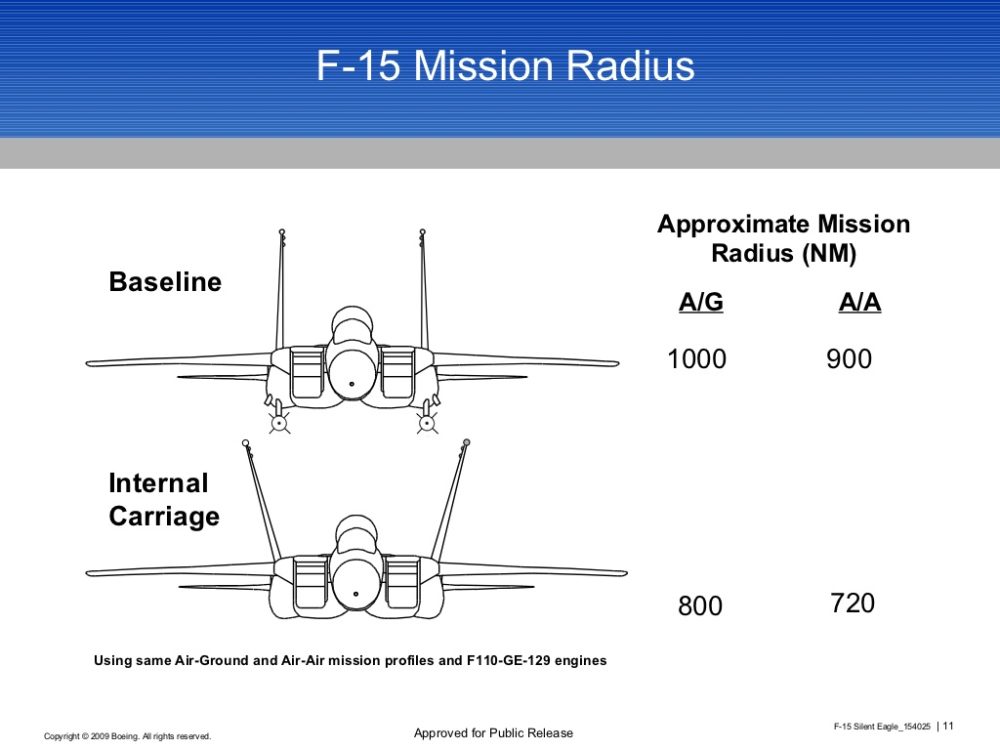
At 63.6 feet long, the Silent Eagle measured slightly shorter than its Strike Eagle predecessor, at 63.8 feet, with an identical wingspan of 42.8 feet. It would be powered by either two General Electric F110-GE-129 turbofan engines providing 29,000lbs of thrust or two Pratt & Whitney F100-PW-229 engines providing the same. According to some sources, the Silent Eagle would be slightly slower than the Strike Eagle, topping out at nearly Mach 2.15, as compared to the Strike Eagle’s Mach 2.5 or better, with the same rate of climb at 50,000 feet per minute and the same 60,000-foot service ceiling. Some Boeing materials, however, claim the Silent Eagle could also exceed Mach 2.5.
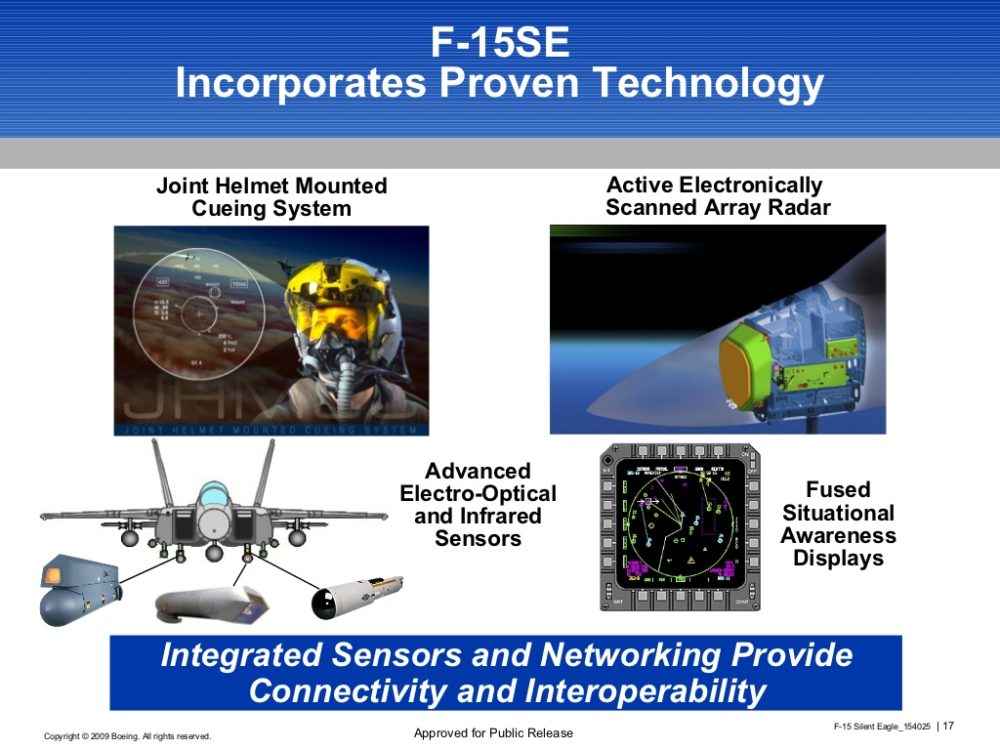
The Joint Helmet Mounted Cueing System, or JHCMS, also added to the Strike Eagle in 2010, would allow the pilot to aim the aircraft’s weapons simply by looking at a target while providing vital information directly in his or her field of view, and an 11in x 19in Large Area Display (LAD) system was included for both the pilot and weapons officer for improved situational awareness.
A 15-degree change in vertical tail positioning can make a world of difference
The other most notable structural difference between the Strike Eagle and Silent Eagle was in the tail. The F-15’s twin vertical tails played a big role in the aircraft’s large radar return, so the Silent Eagle’s tails were canted 15 degrees outward, thus reducing their radar signature while providing a slight boost to lift. That added lift, Boeing claimed, gave their new semi-stealth fighter an additional 75 to 100 miles of range, offsetting a bit of what was lost when swapping out the conformal fuel tanks.
To better understand how a 15-degree change in the vertical tails of an F-15SE could have an appreciable effect on its radar cross-section, let’s look to Alan Brown, who was Lockheed’s first chief engineer for the F-117 Nighthawk. Here’s an incredible 1-minute video where he explains how small changes to angle can result in huge reductions in an aircraft’s radar return. If you aren’t able to watch the video, I’ll include the pertinent quote below.
“Very simply, if I’m looking at a flat surface at right angles to the radar, if something like this were one square meter it would have a radar return of a thousand square meters,” Brown explains holding up a square.
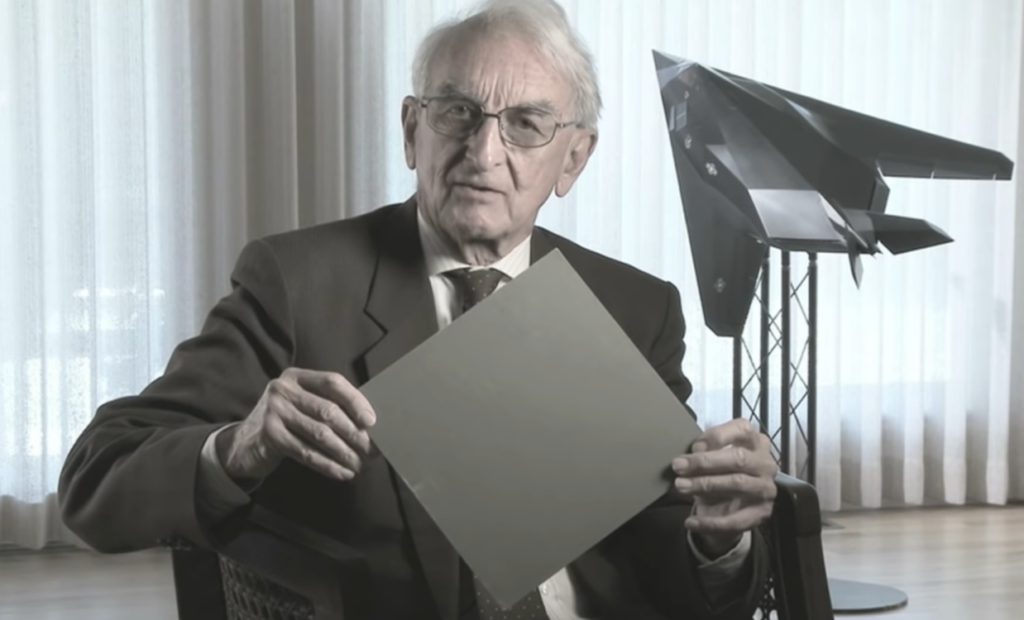
“If I move it back just about eight degrees, not very much, it drops from a thousand square meters to one square meter. And if I move it down to a very shallow angle, like about 20 degrees to horizontal, it’s now down to one ten millionth of what it was when it was up there.”
Of course, aircraft aren’t stationary objects and radar cross-sections vary based on the angle you observe them from. By canting the vertical tails by 15 degrees, the F-15SE could also bank to the same angle without presenting a radar-alerting perpendicular surface to nearby arrays.
While the canted vertical tails and internal weapons storage capabilities both had appreciable effects on the fighter’s radar return, the inclusion of radar-absorbent materials (RAM) in its paint would help press it further toward the low observable side of the spectrum. Radar arrays work by projecting electromagnetic energy into the sky and reading what’s bounced back at it.
“RAM works on the principle of the aircraft absorbing the electromagnetic wave energy to minimize the intensity of the reflected signal,†wrote Adrian Mouritz in the academic textbook “Introduction to Aerospace Materials.â€
RAM is used on modern stealth fighters to minimize the radar return created by the facets of their designs that couldn’t be adjusted to deflect radar waves—things like ramjet inlets, the fighter’s nose, and the leading edges of its wings. But it’s important to remember that these fighters were also designed from the ground up to deflect electromagnetic energy, unlike fourth-generation fighters like the F-15, so the benefit of using RAM is not as pronounced.
Just how much stealth can you cram into an F-15?
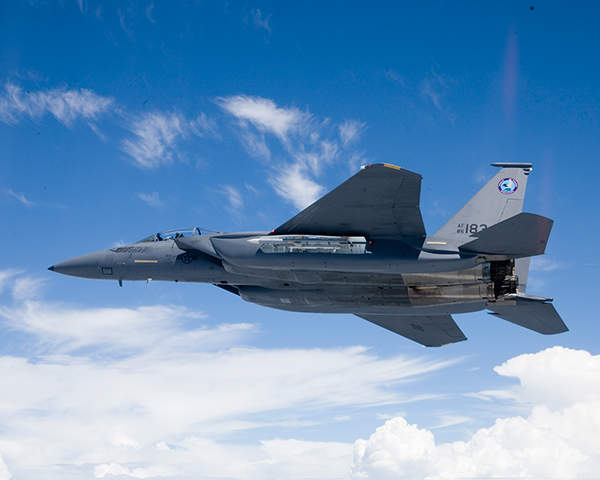
Radar cross sections are widely debated online, and as may as come as little surprise to you, national governments aren’t often in the habit of stepping in to clarify when it comes to their operational fighters. So, we should take everything about this stealth conversation with a grain of salt, as is always the case when speaking hypothetically about cutting-edge and classified technologies.
The F-15 isn’t the only 4th-generation American fighter to get the stealth treatment. Starting in 2012, American F-16s tasked with SEAD missions, or Wild Weasels—as they’re often known, began receiving the 5th generation of radar absorbing “Have Glass” treatments. In effect, these F-16s received the radar-absorbent material treatment one might find on a 5th-generation fighter, and in fact, the paint was applied using the very same CASPER (Computer-Aided Spray Paint Expelling Robot) the Air Force uses to apply radar-absorbent paint to the F-22.
Delaying radar detection is of particular import for Wild Weasel F-16s, as these fighters are tasked with hunting for and engaging surface-to-air missile batteries in enemy airspace.

The first generation of Have Glass treatments were applied to the cockpit canopies of F-16s not unlike applying a gold tint to sunglasses—and believe it or not—were estimated to reduce the F-16’s radar return by as much as 15%. Today, the (ironically named) 5th-generation treatment, which includes the use of RAM paint throughout much of the aircraft, has been estimated to drop the F-16’s radar return by a whopping 76%. In other words, the use of RAM was able to shrink the Viper on radar screens from 5 square meters to a comparably tiny 1.2.
Of course, the F-16 started out with a much smaller radar cross-section than the F-15—at 5 m² and 25 m² respectively—but if we were to apply this same arithmetic to the Silent Eagle, we’re now talking about an F-15 with a radar cross-section of just 6 m² before making considerations for the canted tail sections and internal weapons carriage capabilities. Of course, this is a gross generalization, but with modern RAM rated to absorb 70-80% of inbound electromagnetic energy, it’s beginning to sound like the F-15SE really had a chance at being the sneakiest Eagle this world will ever see.
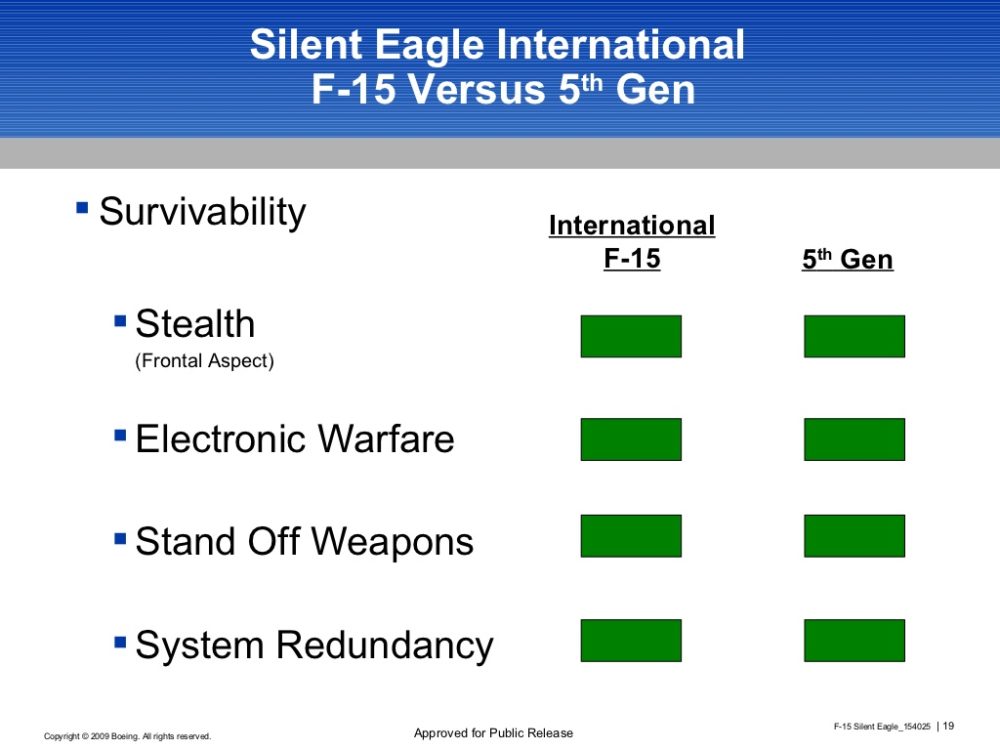
This level of reduction still doesn’t come anywhere near matching the stealth offered by platforms like the F-22 or F-35, which boast estimated radar cross-sections of 0.0001-0.0002m² (the size of a marble) to 0.0015m² (the size of a golf ball) respectively. Some Boeing officials have been quoted as saying that the Silent Eagle would have the same radar cross-section from head-on as an F-35, but Lockheed Martin officials and other defense experts dismissed that comparison as unrealistic, and indeed, a year later, Boeing eased up on their stealth claims, saying only that they had achieved their low-observable goals.
“The Silent Eagle philosophy is that stealth isn’t the end-all. It’s one facet of survivability. We didn’t want to put so much money into stealth and then have technology blow by it,” Jones explained.
“We wanted to maintain the same capabilities that the aircraft already had. Taking all of that into consideration, we came up with the Silent Eagle.â€
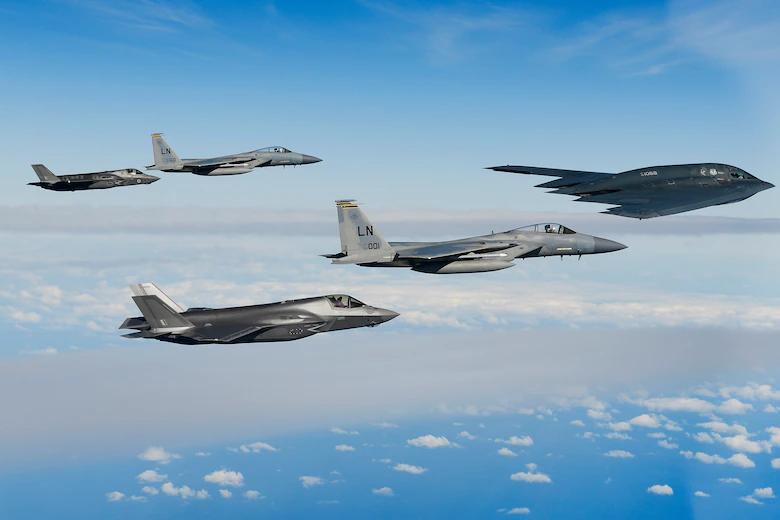
This reduction does delay detection of these aircraft as they approach, giving them time to find and engage their targets before they can be shot down. And the smaller an aircraft’s radar profile, the more it can benefit from friendly electronic warfare assets in the area interfering with enemy radar systems.
In other words, the F-15SE Silent Eagle couldn’t have come close to matching 5th-generation stealth, but it would have offered a massive improvement over existing F-15 airframes on the observability front.
A stealth F-15 is no match for the F-35 (when it comes to finding buyers)
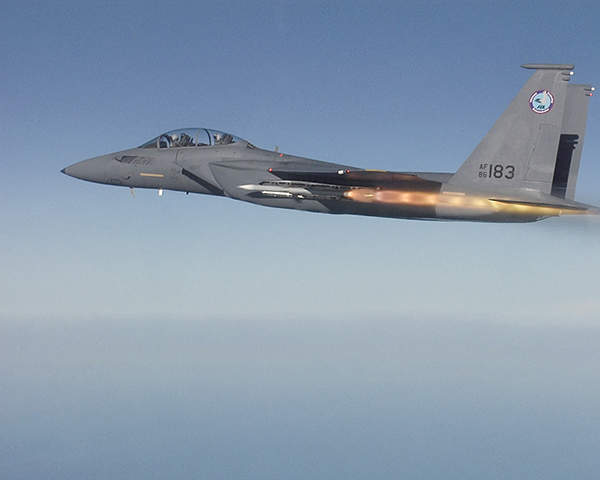
In November of 2010, Boeing signed a Memorandum of Understanding with Korea Aerospace Industries for continued development on the F-15SE’s conformal weapons bays (CWBs). That same month, Boeing showed the world that their Silent Eagle wasn’t just a paper plane, successfully launching an inert AIM-120 from their prototype flight demonstrator’s left CWB.
By 2012, the Silent Eagle was ready to enter into South Korea’s F-X III competition with some stiff competition: the Eurofighter Typhoon and Lockheed Martin’s F-35. The Typhoon was also a 4th generation fighter, but unlike the 1960s era design of the F-15, the Typhoon was developed in the same era as the F-22. While not a stealth fighter per se, the Typhoon carries a reported radar cross-section of just .5 square meters—less than half that of the Have Glass F-16s and likely at least ten times better than Boeing’s stealth injected Silent Eagle.
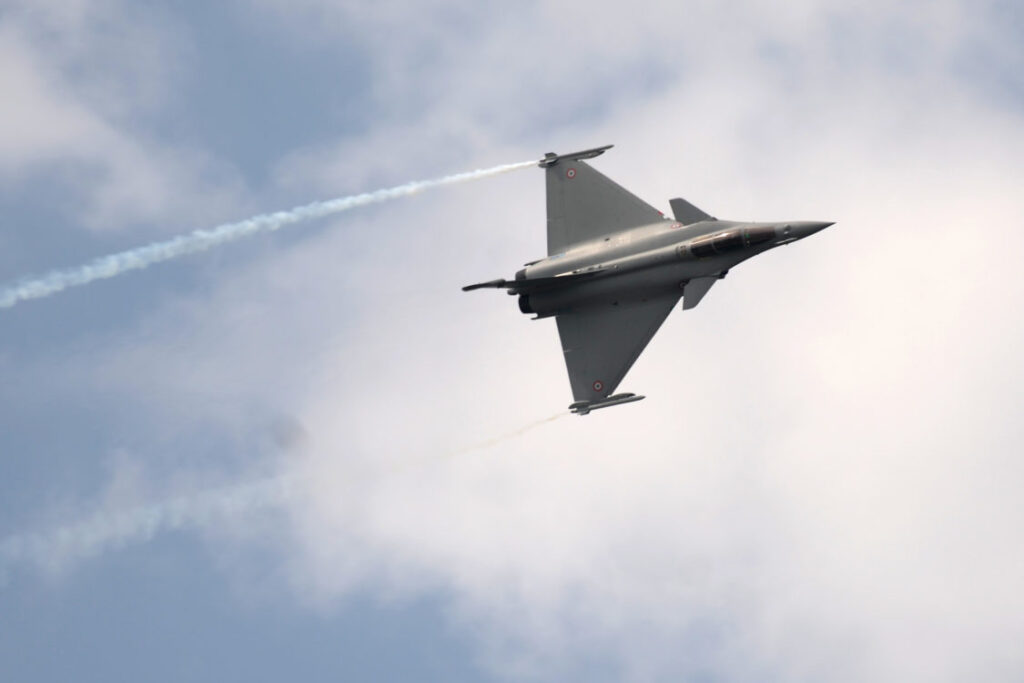
But it would be the F-35, with its state-of-the-art avionics, sensor fusion capabilities, and practically microscopic radar return that would win out in the end. Boeing offered up the Silent Eagle at around $100 million per aircraft, but South Korea ultimately chose to shell out as much as $176.5 million per F-35 to procure 40 truly stealth jets. The F-15SE and Eurofighter Typhoon may have been excellent 4th-generation options, but among fighters in production in 2014 when the deal was signed, the F-35 was practically in a class of its own.
And that would soon become a trend. Between 2009 and 2014, Boeing would go on to market their F-15SE Silent Eagle to Israel, Canada, Japan, and Saudi Arabia. Since then, all of those nations have either signed on to buy F-35s or are still amid negotiations to do so.
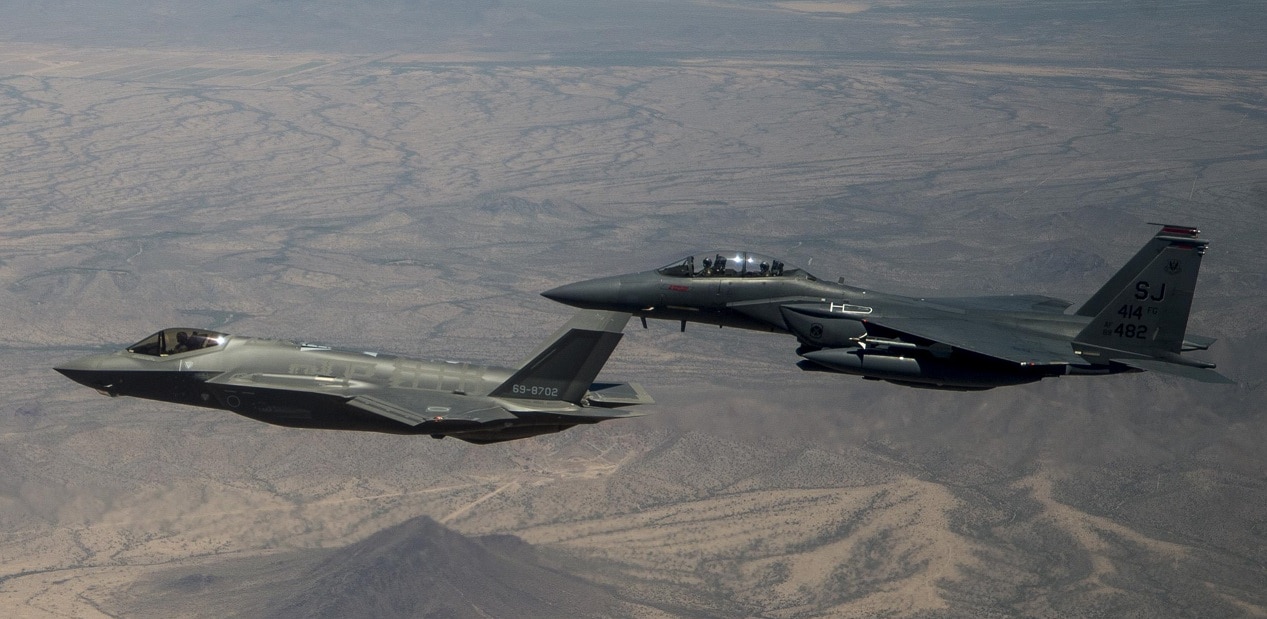
Israel may have been the closest to bringing the fighter to fruition when they asked for a squadron of Silent Eagles as a defense reassurance after the West entered into the now-defunct nuclear treaty with Iran that aimed to end the nation’s nuclear weapons programs. But eventually, like each nation before, Israel also moved on from the stealth-infused F-15, opting instead to order more F-35s. The Silent Eagle effort effectively died at that point in 2015, but of course, that wasn’t the end of this story.
In July of 2020, the U.S. Air Force signed a $1.2 billion deal with Boeing to kick start production of yet another iteration of the F-15 in the F-15EX Eagle II. This new fighter leverages many of the updates and upgrades originally slated for the Silent Eagle, including fly-by-wire capabilities, AN/APG-82 active electronically scanned array (AESA) radar system, electronic warfare suite, and updated glass cockpit.
The Eagle II doesn’t have canted tails, but may till leverage some radar-return-reducing elements. Last summer, Combat Aircraft reporter Rob Coppinger asked Boeing officials if we could expect to see the use of RAM on the F-15EX, and the response wasn’t no. Instead, they simply said the answer is “likely to be classified.â€
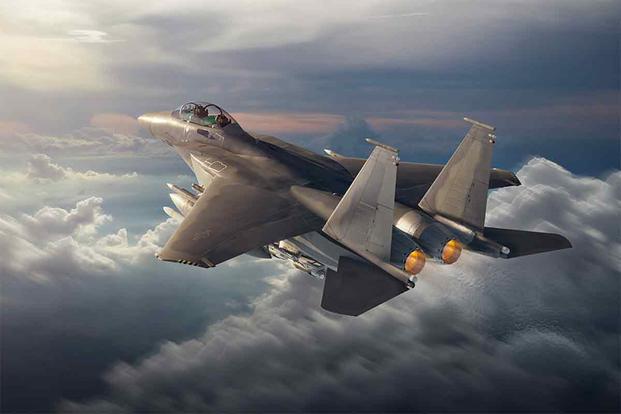
The F-15EX will also soon boast the new AN/ALQ-250 Eagle Passive/Active Warning and Survivability System (EPAWWS) from BAE systems, granting not only a huge boost in situational awareness but in offensive detection-jamming and spoofing capabilities. The system uses “Multi-spectral, RF countermeasures” as well as non-interference jamming capabilities to trick enemy radar into missing the decidedly large RCS of the Eagle II, making it not as stealthy as the Silent Eagle could have been, but easily the stealthiest F-15 ever to make it into service.
Today, with fighter programs like the Air Force’s Next Generation Air Dominance, the U.K.’s Tempest, and Europe’s Future Combat Air System in the works, it seems a lot less likely that we’ll ever see a stealth F-15 find its way into production. It just makes more sense to invest in the next generation of fighters rather than the last one. But the fact that a few slight changes could have made the legendary F-15 a viable competitor for years to come speaks volumes about just how incredible this airframe really is in the first place.
The F-15 may have been the 20th century champ, but it looks like it’s still got some years left in it after all.
